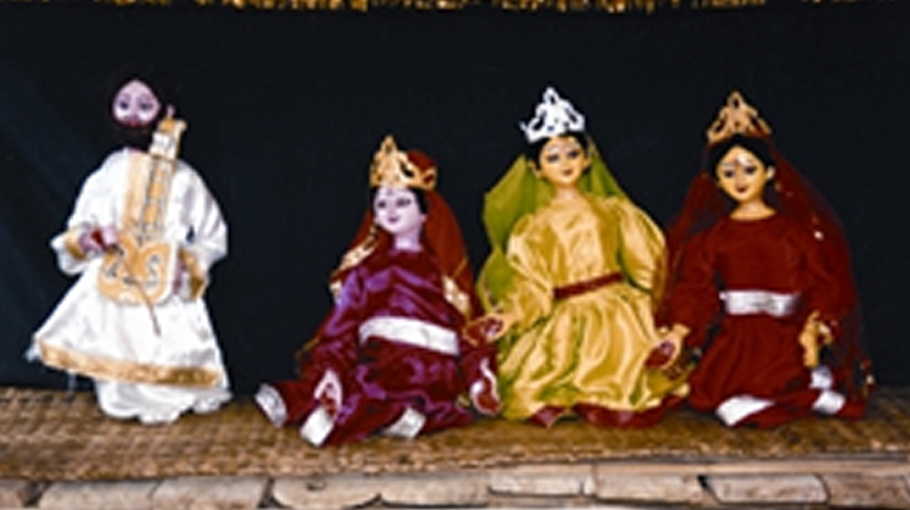Nabinagar’s traditional puppet dance on the verge of extinction

The puppet dance of Nabinagar in Brahmanbaria is an ancient tradition of Bangladesh and the Indian subcontinent. Once upon a time puppet dance played an important role in the entertainment of the young and old in the rural town especially in the entertainment of children. Krishnanagar is an ancient town built on the banks of Titus in Nabinagar upazila of Brahmanbaria district.
In this village on December 31, 1879, Ustad Bipin Das, the father of puppet dance of the Indian subcontinent, was born in the house of his father Vrindavan Das. Even though he was born as the only child of his parents, he spent his childhood-adolescence in Guru Griha. He married Tulsi Bala in the neighboring village of Merkuta. In family life, he was the father of four sons and three daughters. The sons are Ustad Gopal Das, Ustad Govinda Das, Anil Das, and Arjun Das. The girls are Dashabala, Sadhanbala and Charu Bala.
At that time, boats and ships loaded with jewelery and goods used to come and go to Calcutta via Narayanganj from Montala Ghat. Many people call him Bipin Majhi as Bipin Das also worked for some time with his grandfather Gagan Das who was in charge of these ships. As a teenager, he saw dolls made of clay and dreamed that if they could be danced, then many things could be said in the rhythm of the dance. Bipin Pal of Krishnanagar village in Nabinagar in the Indian subcontinent introduced the first modern puppet dance. Bipin Pal is said to have danced puppets based on mythological stories considering the social context of the time. Apart from this, various scenes of rural life are highlighted in it. Sometimes Kathuria is depicted as being attacked by tigers, or the tragic outcome of fishermen being eaten by crocodiles.
The presence of people from all walks of life, from children to the elderly, was a sight to behold. There was no limit to the children's joy when they saw puppets dancing. From this idea, he first started making clay puppets, gods and goddesses in different shapes and gradually made stick puppets, spring puppets and thread puppets. He along with some disciples from the same area created a spectacle by creating puppet dances. Seeing the huge popularity, along with his family Moti Mia, Ramnath Babu, Tarumia and Siddique Mia increased the promotion and spread of puppet dance. His disciples stayed with the master for many years and later formed puppet dance groups in different areas.
Once upon a time, Meddar Dhan Mia, Kalu Mia, of Brahmanbaria city. Raj Hossain, Sharif Maldar of Kazipara and a few houses of Kandpara were greatly influenced by the charm of puppet dance and created a puppet dance troupe themselves and made this puppet dance troupe popular throughout the country including Brahmanbaria, Comilla, Mymensingh, Narsingdi, Bikrampur, Sylhet, Noakhali, Chittagong. Apart from that, at that time in some areas of Faridpur and Rajshahi regions, the practice and popularity of puppet dance was creating a stir. Bipin Das accompanied his two sons Gopal Das and Govinda Das to teach this profession and they also became masters and spread Bipin Das' dream puppet dance all over India. Ustad Gopal Das went to India under the direction of his father Bipin Das and made numerous disciples in different areas to form and introduce puppet dance troupes. As a result, its wide popularity and fame with the introduction of Bipin Das increased throughout India. Not only India, he traveled to around 27 countries of the world with this puppet dance troupe. In recognition, Bipin Das received various medals and awards posthumously from many eminent persons and institutions, including former Presidents of India. Ustad Gobind Das along with his father tried to promote Kanache puppet dance all over the then East Pakistan and independent Bangladesh by forming groups and making it known. Ustad Gobind Das initiated his son Badal Das into this profession and has been conducting his activities till today with three puppet dance troupes named "The Royal Bengal Puppet Dance", "Sajher Bati Puppet Dance" and "Sandhyamalati". Bipin Das was quite adept at using various musical instruments and playing musical instruments. He could play numerous musical instruments including sitar, harmonium, tabla, mudi patil - jhala. Ustad Bipin Das was a maestro on raudraveena and Khaiman veena. He created the "Badhakala" bowl himself in the tabla bowl. He made several silent films during the British rule. Among them - Dadhi Farshasha, Jharshabhapavah Davit, Itarshabha Raffarshadhavat Ngushav etc. Apart from this, Sabak produced the films - "Sona Ganger Nona Majhi" and the last film of his life - "Shoe Nadia Jage Pani" made jointly in East and West Pakistan in 1962. The Bipin Pal puppet dance troupe had 14 members. Among them, 10 people operated the puppets to the rhythm of the song. The rest played musical instruments and sang. The famous puppet dances of the country are 'Manhara', 'Rajkanya Monik Mala', 'Sitaar Banbas', 'Roopban', 'Poor Boy', 'Poor Girl', Hingsar Parinam', 'Prem Sarthak' and 'Gazi Kalu'. 'Gunai Sundari', 'Sagar Vasa', 'Ferrari Samrat', 'Nach Mahal', 'Beggar's Son' are among the puppet dance turns. Apart from this, puppet dances were an important means of entertainment in rural villages. Bipin Das was the pioneer and guide of this huge popularization of the folk culture of rural Bengal.




